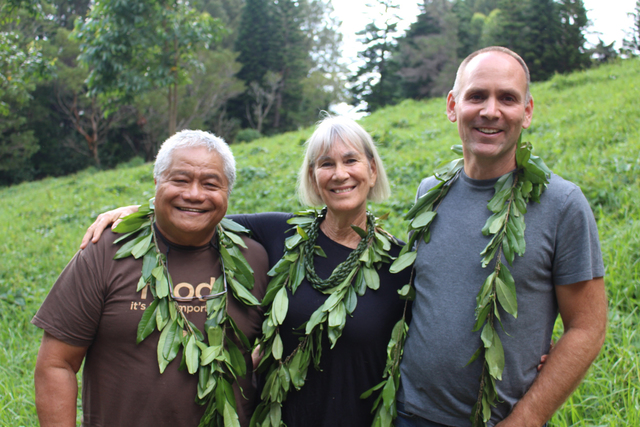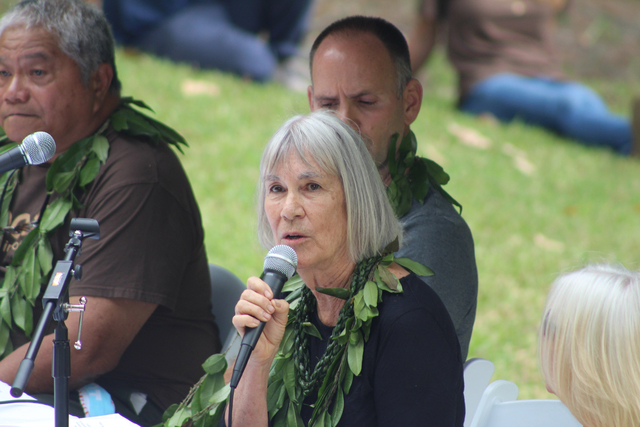WAIMEA — How to increase food security and support local food production in Hawaii is a topic that’s on nearly everyone’s plate these days.
In a state that can grow 365 days a year with favorable weather, water and soil, Hawaii grows only about 10 percent of what its residents and visitors eat. And an estimated 85 percent of all the food available in Hawaii’s supermarkets and restaurants at any given time is imported from 2,300 miles away or more.
Gov. David Ige pledged to double local food production by 2030 before a crowd of thousands at the World Conservation Congress in Honolulu last week.
So it is particularly apropos that The Kohala Center chose food production and food security as the subject matter for its second Waiwai Weekend discussion series in Waimea on Aug. 20.
The conversation featured local experts Nancy Redfeather, Dr. Albie Miles and Jerry Konanui sharing their thoughts and experiences on how to grow and produce more local food, and support local farmers and food producers.
Currently, Hawaii has only about 7,000 farmers statewide.
Redfeather, who retired recently as director of The Kohala Center’s Hawaii Island School Garden Network, feels work being done in 60 school gardens on the island addresses many of the problems children are having today.
“The school garden is a place where students can experiment with diversity,” she said. “They can connect it to their classroom studies and learn how to care for and love the environment so they’ll know how to take care of it when they grow up and make better decisions for their life.”
Quoting Kaiser Permanente, Redfeather said if trends keep going in the same direction, one out of every three children will be on dialysis in their lifetimes, “which is unacceptable.”
“We want kids to know what good food is, care about how it’s grown and eat it every day so they won’t be one of those of those 56 percent of all adults today who have one of the seven chronic diseases,” she said. “These programs are going to need continual support by the community.”
Miles, who serves as the assistant professor of sustainable community food systems at the University of Hawaii (UH) West Oahu, addressed the fundamentals of food production. He said that strong empirical research shows organic farming systems outperform conventional industrial methods across every single environmental performance metric.
“So, one of the key things we can do to advance ecological sustainability in the food and agriculture sectors is to promote alternative, traditional and certified organic farming systems,” Miles said.
Collaborative projects currently under way for UH West Oahu include a Comprehensive Statewide Farmer Needs Assessment in conjunction with the UH College of Tropical Agriculture and Human Resources.
“I’m not sure how many times farmers in our state have been contacted to ask, ‘What needs do you have?’ ” Miles said. “We’re helping connect farmers with existing resources to help them make farming operations more economically viable.”
The department is also working in collaboration with numerous entities to advance a 200-acre research education extension project on its West Oahu campus that’s currently in the development phase.
“We’d have a farmer training program, incubator farm project, a shared value-added food processing facility and research fields, a restaurant and a retail nursery all under one umbrella at the UH West Oahu,” Miles said. “And all of those are key components, I believe, in helping to drive fundamental food system change for Oahu and the state.”
Konanui, who lives in Puna, brought three generations of ike kapuna (ancestral knowledge) to the group discussion. He said each heritage plant of Hawaii was intentionally given a name and purpose when grown by Native Hawaiians.
“So when you plant, you need to have the intention and purpose of what you’re doing,” Konanui said. “This type of knowledge is vital. Growers also need to know the techniques used by our kupuna. For example, ‘Did you know there are more than seven methods of planting taro in the loi (taro pond) or that there are more than seven methods for dry land?’ (With this knowledge) if you’re in the desert, you can survive. If you’re in the wetland forest, you can survive. It’s all about which plant to grow, and it’s not a stagnant thing because just like human beings, plants are dynamic organisms that move, fluctuate and bend.”
Redfeather summed up the discussion noting that on the Big Island, 96 percent of the land is owned by the federal, state and county governments and large landowners of 5,000 acres or more. Very little land is available for fee simple sale and that’s almost the same for every island.
To make more land available, accessible and affordable for farming, she’s advocating land reform.
“I don’t know what that’s going to look like, but it needs to be creative and it needs to work for everybody,” Redfeather said. “We need to think about land reform because in order to have the amount of food we’re going to need in a food security crisis, we’re going to have to produce more food and it could be on small family farms.”
Another problem she cites is that the Hawaii State Department of Agriculture currently receives less than 1 percent of the total state budget. Given Hawaii’s potential to grow more of its own food, she called for greater legislative support.
“We could be the leader of these small food systems and food security for the entire world,” Redfeather said.
She noted that she is sometimes met with skepticism about the islands’ potential to produce more food.
“But I just say to them, ‘Come to my farm sometime and see what we’re doing. You could see that there is totally a way to do this that will work,’” Redfeather concluded.






